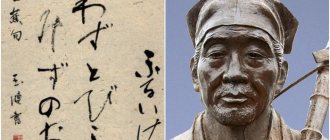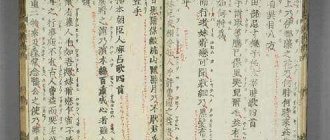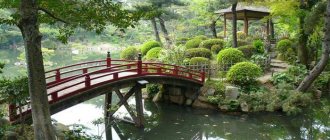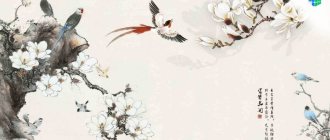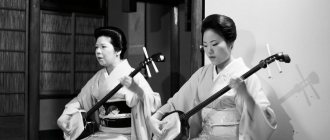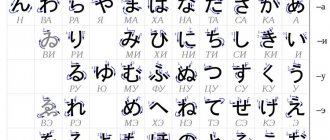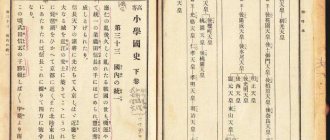Those whose native language is Russian do not always understand the beauty and grace of traditional Japanese haiku (or haiku) poems. And it’s not surprising, because the original haiku were written in Japanese, which is strikingly different from Russian in sound and intonation.
A special feature of haiku is the special structure of the poem.
Firstly , all words must consist of 17 syllables in total.
Secondly , the entire work must fit into 3 lines.
Thirdly , the syllables are distributed along the lines like this:
- 5 syllables in the first line
- 7 syllables in the second line
- 5 syllables in third line
Fourthly , the lines in the poem are not arranged chaotically, but are built according to a certain pattern:
- the first line contains initial information about the place, time and essence of the event.
- the second line reveals the meaning of the first, filling the moment with special charm.
- the third line represents conclusions that very often reflect the author’s attitude to what is happening, and therefore can be very unexpected and original.
If you are a parent, you are probably surprised and even indignant - how can you force a 2nd grade haiku to be written? We, too, are perplexed and therefore decided to conduct an experiment: we invited our colleagues to come up with a haiku (hoku) for 2nd grade children and see what came of it.
Here are some haiku poems for grade 2:
Haiku without a seasonal word
Let's look at an example of haiku that can be classified in this group:
A cat is walking along a city street, the windows are open.
Here, the indication of what time of year the animal left home is not important - the reader can observe the picture of the cat leaving home, completing the complete picture in his imagination. Perhaps something happened at home that the owners did not pay attention to the open window, and the cat slipped through it and went for a long walk. Maybe the owner of the house is anxiously waiting for her four-legged pet to return. In this haiku example, it is not necessary to indicate the season to describe feelings.
Haiku poems: examples for children
Often schoolchildren receive homework assignments to learn or compose haiku. These short poems are easy to read and quick to remember. This is demonstrated by the following example of haiku (2nd grade is too early to cover Japanese poetry, but students can refer to this tercet if necessary):
The sun sets, And the cobwebs also melt in the darkness...
The author of this laconic poem is Basho. Despite the capacity of the tercet, the reader must use his imagination and partially participate in the creative work of the Japanese poet. The following haiku is also written by Basho. In it, the poet depicts the carefree life of a little bird:
In the free meadows the lark bursts into song without labor or worries...
Many readers are wondering how to write haiku in Russian. Examples of these tercets show that one of the main features of this genre of poetry is the correlation of a person’s internal state with the time of year. This rule can also be used when composing your own haiku. The rules of classical versification required the use of a special “seasonal” word - kigo. It is a word or phrase that indicates the season described in the poem.
For example, the word "snow" would indicate winter. The phrase “Hazy moon” may indicate the onset of spring. Mention of sakura (Japanese cherry tree) will also indicate spring. The word kinge - “goldfish” - will indicate that the poet depicts summer in his poem. This custom of using kigo came into the haiku genre from other forms. However, these words also help the poet choose laconic words and give the meaning of the work even greater depth.
The following haiku example will tell about summer:
The sun is shining. The birds became quiet at noon. Summer has come.
And after reading the following Japanese tercet, you can understand that the season being described is spring:
Cherry blossoms. Dali was shrouded in fog. Dawn has arrived.
Is there always a hidden meaning in Japanese tercets?
Looking at various examples of haiku, one can see the simplicity of these tercets. Many of them lack hidden meaning. They describe ordinary natural phenomena perceived by the poet. The following example of haiku in Russian, authored by the famous Japanese poet Matsuo Basho, describes a picture of nature:
A raven turns black on a dead branch. Autumn evening.
This is how haiku differs from the Western poetic tradition. Many of them have no hidden meaning, but reflect the true principles of Zen Buddhism. In the West, it is customary to fill every thing with hidden symbolism. This meaning is not found in the following example of nature haiku, also written by Basho:
I'm walking along the path up the mountain. ABOUT! How wonderful! Violet!
Japanese haiku and European poem
Haiku is the greatest treasure of Japanese literature. Any educated Japanese knows haiku, and many try to compose them. There is great interest in Japanese poetry throughout the world.
Haiku is a short poem of just three lines. There is no rhyme in it, and only rhythm distinguishes it from prose. The first and third lines have five syllables, the second - seven. The incredible brevity of haiku does not prevent it from conveying its deep philosophical meaning.
Sometimes the tercets were composed as an inscription to the picture, sometimes, on the contrary, you want to paint a picture for the tercet. For example, to this:
The autumn moon draws a pine tree with ink in the blue skies.
When a Japanese artist paints autumn, he depicts a single tree, beaten by the rains and bent by the wind. But before he takes up his brush, he looks at a blank sheet of paper for a long time. Then several clear lines appear, simple-minded but precise, which excite the soul no less than Levitan’s landscapes. “For a Japanese artist to draw a branch, he must feel how it grows,” say art connoisseurs.
Same thing in hockey. Its apparent brevity is deceptive. There is a deep subtext hidden in it, and it is ambiguous. Everyone can read it in their own way, find consonance with their thoughts.
To more clearly see the difference between haiku and European poetry, let us compare the morning in the description of I. Nikitin and the Japanese poet Busson. In Nikitin, from the first rays of the sun until the moment when the sun “gushes in golden streams on the fields, on the meadows, on the tops of the willows,” there are twenty-four lines, where the poet tried to cover all the details of the awakening: here are “sensitive reeds” and “silver dew” , and the noise of disturbed ducks, and awakening fishermen with nets, oars, and boats. There is also a cheerful greeting from the author: “Hello, sun and merry morning!” Busson has only three lines:
A flock of ducks in the distance. I rinse the hoe - ripples in the water.
The same flock of ducks, the same ripples on the water. And the same picture of the morning, where there is dew, and steam over the water, and the first rays of the sun. But all this is between the lines. This is the space of the painting, filled not by the artist, but by the viewer, the reader.
There is one more feature of haiku. Whatever the poems of a Japanese or European poet are about, they are always about a person. In haiku, the presence of nature is mandatory. Nature is a reflection of the poet’s spiritual life. To convey his state, the Japanese poet chooses a season and a “picture” in nature that matches his mental makeup. Then he discards those details that are least expressive. And only three lines remain: Material from the site //iEssay.ru
A raven sits alone on a bare branch. Autumn evening.
We can say that where the European poet strives for accuracy, reproducing all the nuances and shades, the Japanese poet ruthlessly discards everything unnecessary. The European poet seems to be saying to the reader: “Look, I have revealed to you something that you did not notice or appreciate.” And the Japanese trust their reader, offering him a sketch for the picture, which he will complete himself. And in this involvement in creativity there is great joy.
Japanese and European poetry reach the reader along different roads. But the feelings it awakens are the same for all people. We are all sad from loneliness, suffer from separation and mental pain, rejoice in the morning and the sun and bow before the great wisdom of nature. And that’s why Roseki’s lines are so close to us:
Not a soul around - The Green Moon wanders alone in the field.
Didn't find what you were looking for? Use search ↑↑↑
On this page there is material on the following topics:
- Japanese haiku works
- Japanese haiku writers short biography
- essay on the topic of poetry of the East of the Middle Ages
Rules for drafting and examples of haiku
Japan is a country with a very unique culture. Its formation was greatly facilitated by the peculiarities of the geographical location and geological factors. The Japanese were able to settle in the valleys and coasts, but they constantly suffer from typhoons, earthquakes, and tsunamis. Therefore, it is not surprising that their national consciousness deifies natural forces, and poetic thought strives to penetrate into the very essence of things. This desire is embodied in laconic forms of art.
Writing Tips
James Hackett, who was one of the most influential Western writers of haiku, believed that these tercets convey sensations “as they are.” And this is precisely what is characteristic of Basho’s poetry, which shows the immediacy of the current moment. Hackett gives the following tips to help you write your own haiku:
- The source of the poem must be life itself. They can and should describe daily events that at first glance seem ordinary.
- When composing haiku, one should contemplate nature in the immediate vicinity.
- It is necessary to identify yourself with what is described in the tercet.
- It is always better to think alone.
- It's better to use simple language.
- It is advisable to mention the time of year.
- Haiku should be simple and clear.
Hackett also said that anyone who wants to create beautiful haiku should remember the words of Basho: “Haiku is the finger that points to the moon.” If this finger is decorated with rings, then the attention of the audience will be focused on these jewelry, and not on the heavenly body. The finger does not need any decoration. In other words, various rhymes, metaphors, similes and other literary devices are unnecessary in haiku.
Source of the article: https://www.syl.ru/article/370124/pravila-sostavleniya-i-primeryi-hokku
General and specific in haiku
It is known that the Japanese people have a cult of nature. In the Land of the Rising Sun, the surrounding world is treated in a completely special way - for its inhabitants, nature is a separate spiritual world. In haiku, the motive of the universal connection of things is manifested. Specific things that are described in tercets are always connected with the general cycle; they become part of a series of endless changes. Even the four seasons of the year are divided by Japanese poets into shorter subseasons.
The first drop from the sky fell on my hand. Autumn is approaching.
Features of Japanese poetry
Before considering examples of haiku, it is necessary to pay attention to the features of the art of the Land of the Rising Sun. This brevity is expressed in different ways. It is also characteristic of the Japanese garden with its empty space, and origami, and works of painting and poetry. The main principles in the art of the Land of the Rising Sun are naturalness, understatement, and minimalism.
In Japanese, words don't rhyme. Therefore, the poetry familiar to the average person in our country could not emerge in this language. However, the Land of the Rising Sun gave the world no less beautiful works called haiku. They contain the wisdom of the eastern people, their unsurpassed ability to understand through natural phenomena the meaning of existence and the essence of man himself.
Haiku - the poetic art of the Land of the Rising Sun
The careful attitude of the Japanese towards their past, towards the heritage of antiquity, as well as strict adherence to the rules and norms of versification, turned haiku into a genuine art form. In Japan, haiku is a separate type of skill - for example, like the art of calligraphy. It acquired its true capacity at the end of the 17th century. The famous Japanese poet Matsuo Basho managed to raise it to an unsurpassed height.
The person portrayed in the poem is always against the backdrop of nature. Haiku is intended to convey and show phenomena, but not to name them directly. These short poems are sometimes called "pictures of nature" in the art of poetry. It is no coincidence that artistic canvases were also created for haiku.
